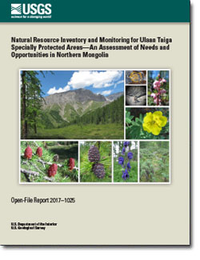Natural resource inventory and monitoring for Ulaan Taiga Specially Protected Areas—An assessment of needs and opportunities in northern Mongolia
Links
- Document: Report (3.5 MB pdf)
- Download citation as: RIS | Dublin Core
Abstract
Between 1997 and 2011, Mongolia established three specially protected areas in the north-central part of the country to protect various high-value resources. These areas are jointly referred to as the Ulaan Taiga Specially Protected Areas. In accordance with the goals of the draft general management plan, this report identifies options for initiating an inventory and monitoring program for the three protected areas. Together, the three areas comprise over 1.5 million hectares of mountainous terrain west of Lake Hovsgol and bordering the Darkhad Valley. The area supports numerous rare ungulates, endangered fish, and over 40 species of threatened plants. Illegal mining, illegal logging, and poaching pose the most immediate threats to resources. As a first step, a review of published literature would inform natural resource management at the Ulaan Taiga Specially Protected Areas because it would inform other inventories.
Vegetation classification and mapping also would inform other inventory efforts because the process incorporates geographic analysis to identify environmental gradients, fine-scale sampling that captures species composition and structure, and landscape-scale results that represent the variety and extent of habitats for various organisms. Mapping using satellite imagery reduces the cost per hectare.
Following a determination of existing knowledge, field surveys of vertebrates and vascular plants would serve to build species lists and fill in gaps in existing knowledge. For abiotic resources, a focus on monitoring air quality, evaluating and monitoring water quality, and assembling and storing weather data would provide information for correlating resource response status with changing environmental conditions.
Finally, we identify datasets that, if incorporated into a geographic information system, would inform resource management. They include political boundaries, infrastructure, topography, surficial geology, hydrology, fire history, and soils.
In terms of tracking high-value resources, vegetation monitoring at the plot scale would provide a basis for detecting change in such characteristics as plant species composition, vegetation structure, and productivity that are associated with landscape-scale factors such as climate change or biotic interactions. Continued population monitoring of rare ungulates, particularly argali or wild sheep (Ovis ammon), would provide information on how populations are responding to natural and anthropogenic stressors. Siberian taimen (Hucho taimen) also is an important monitoring target given ongoing threats of poaching and climate change.
Suggested Citation
Moore, P.E., Meyer, J.B., and Chow, L.S., 2017, Natural resource inventory and monitoring for Ulaan Taiga Specially Protected Areas—An assessment of needs and opportunities in northern Mongolia: U.S. Geological Survey Open-File Report 2017–1025, 35 p., https://doi.org/10.3133/ofr20171025.
ISSN: 2331-1258 (online)
Study Area
Table of Contents
- Acknowledgments
- Abstract
- Introduction
- Protected Areas
- Natural Resource Inventories
- Monitoring
- Research to Inform Natural Resource Inventory and Monitoring
- Conclusions
- References Cited
- Glossary
- Appendixes 1–4
| Publication type | Report |
|---|---|
| Publication Subtype | USGS Numbered Series |
| Title | Natural resource inventory and monitoring for Ulaan Taiga Specially Protected Areas—An assessment of needs and opportunities in northern Mongolia |
| Series title | Open-File Report |
| Series number | 2017-1025 |
| DOI | 10.3133/ofr20171025 |
| Publication Date | March 10, 2017 |
| Year Published | 2017 |
| Language | English |
| Publisher | U.S. Geological Survey |
| Publisher location | Reston, VA |
| Contributing office(s) | Western Ecological Research Center |
| Description | viii, 35 p. |
| Country | Mongolia |
| Other Geospatial | Ulaan Taiga Specially Protected Areas |
| Online Only (Y/N) | Y |


